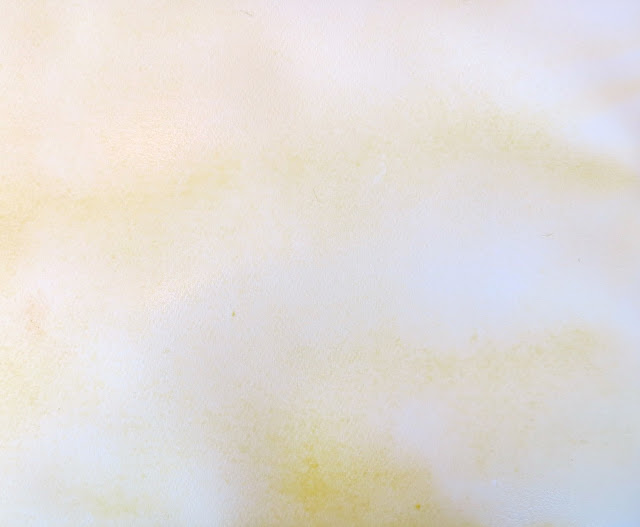In this project, we will be painting the negative shapes, instead of the trees themselves. With each step, you will see the trees emerge, further and further back in space. This is a great way to get a feeling of depth in your landscapes.
The first step is to choose three colors (a triad). I chose Quinacridone Gold, Quinacridone Rose, and Cobalt Turquoise, but you could use any yellow, red, and blue. Do a wet-in-wet mingling of those three colors on your paper . . .
When there is a wet sheen on your paper, sprinkle on some salt . . .
After the paper is totally dry, brush off all the salt . . .
Now, do a simple drawing -- a foreground line, a tree with a few branches, and a line near the top of your paper, indicating leaves -- very stylized . . .
You're now going to paint the negative shapes you've created. For this, you will use the Rose and the Turquoise, but not the Gold. Replace the Gold with Burnt Sienna or Quinacridone Burnt Orange. With these 3 colors, do wet-in-wet mingling within each NEGATIVE SHAPE -- and sprinkle these shapes with salt . . .
When this is totally dry, brush off the salt, and draw -- another ground line, 2 trees with some branches, and another leaf line. Make sure the ground line is above the first ground line and the leaf line is below the first leaf line. Also, make the tree trunks slightly narrower than the first tree . . .
For these negative shapes, omit the Rose, and just use the Burnt Sienna (or Burnt Orange) and the Turquoise (Blue). Once again, keep this painting very transparent; but, this time, do not use the salt . . .
After this is dry, draw again -- another ground line, a few more trees, and another leaf line. This time, omit the Burnt Sienna, and add a cool color to the Turquoise. I painted these negative shapes with the Cobalt Turquoise and Undersea Green, but you could add a transparent blue to the Turquoise, like a Phthalo Blue . . .
After allowing it to dry, draw a sloping ground line, a few more trees, and another leaf line . . .
Now, paint the last of your negative shapes. For this distant space, I omitted the Turquoise, and just used the Undersea Green . . .
And, voila'! You have a forest!



















































